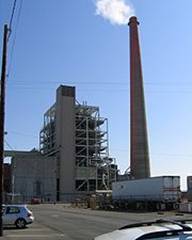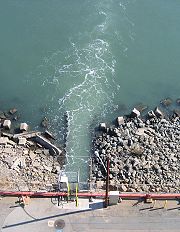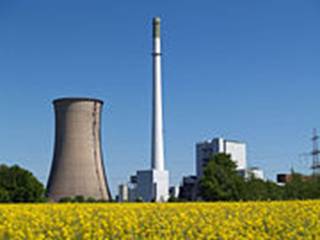Thermal Pollution:
It is caused by addition of hot effluents and hot water bodies. Warm water contains less oxygen. So there is decrease in rate of decomposition of organic matter. Green algae are replaced by less desirable blue green algae. Many animals fail to multiply. Trout eggs fail to hatch while salmon does not spawm at higher temperature.
Thermal pollution is the rise or fall in the temperature of a natural body of water caused by human influence. A common cause of thermal pollution is the use of water as a coolant by power plants and industrial manufacturers. When water used as a coolant is returned to the natural environment at a higher temperature the change in temperature impacts organisms by (a) decreasing oxygen supply, and (b) affecting ecosystem composition. Urban runoff--storm water discharged to surface waters from roads and parking lots--can also be a source of elevated water temperatures.

Potrero Generating Station
Thermal pollution can also be caused by the release of very cold water from the base of reservoirs into warmer rivers. This affects fish (particularly their eggs and larvae), macroinvertebrates and river productivity.
This has become an increasing and the most current pollution, owing to the increasing call of globalization everywhere. Heat produced from industries is a major contribution to the pollution, much to the operation of the heavy industries which produces high amount of heat energy. As we will show a summary to the event of this pollution happening:

Return flow of heated wate to San Francisco Bay from the Potrero Generating Station
- Raw materials for productivity (organic and inorganic products)
- Undergo different chemical reactions with several process
- Excess heat energy is produced as a waste product
- Heat is released through into atmosphere (vapor) and riverine system (liquid).
- Increase of temperature of environmental system
Measurements of atmospheric temperature are done by meteorological center of the weather forecast annually, and the graph to detect the temperature trend from a period of 10 years will be compared with the previous batch of period. Thus we may be able to know the rate of temperature increase overall and make reference to the standard level of heat that should be maintain in the atmosphere to avoid large deviation of heat in the system.
Sources and Methods
We can classify major sources that lead to thermal pollution to the following categories:
- Power plants creating electricity from fossil fuel
- Water as a cooling agent in industrial facilities
- Deforestation of the shoreline
- Soil erosion
- Agriculture sources
Use of high yielding varieties of crops increased the demand for fertilizers are carried to ground water by leaching. They are also added through surface run off. Many pesticides are non-degradable. Huge amount of animal excreta-dung, piggeries are either discharged into grazing fields or dumped into pits.
These are later carried either by surface run-off or get percolated into under-grounded water. Lack of potable drinking water supply, unhygienic habits and poor waster disposal have aggravated problem of water pollution. To evade water pollution regulations and to avoid cost of treatment, industries are disposing off their wastes on ground which has lead to large scale pollution of underground water.
Ecological effects — warm water
Elevated temperature typically decreases the level of dissolved oxygen (DO) in water. The decrease in levels of DO can harm aquatic animals such as fish, amphibians and copepods. Thermal pollution may also increase the metabolic rate of aquatic animals, as enzyme activity, resulting in these organisms consuming more food in a shorter time than if their environment were not changed. An increased metabolic rate may result in food source shortages, causing a sharp decrease in a population. Changes in the environment may also result in a migration of organisms to another, more suitable environment and to in-migration of fishes that normally only live in warmer waters elsewhere. This leads to competition for fewer resources; the more adapted organisms moving in may have an advantage over organisms that are not used to the warmer temperature. As a result one has the problem of compromising food chains of the old and new environments. Biodiversity can be decreased as a result.

Fish killed in receiving waters
It is known that temperature changes of even one to two degrees Celsius can cause significant changes in organism metabolism and other adverse cellular biology effects. Principal adverse changes can include rendering cell walls less permeable to necessary osmosis, coagulation of cell proteins, and alteration of enzyme metabolism. These cellular level effects can adversely affect mortality and reproduction.
Primary producers are affected by warm water because higher water temperature increases plant growth rates, resulting in a shorter lifespan and species overpopulation. This can cause an algae bloom which reduces the oxygen levels in the water. The higher plant density leads to an increased plant respiration rate because the reduced light intensity decreases photosynthesis. This is similar to the eutrophication that occurs when watercourses are polluted with leached agricultural inorganic fertilizers.
A large increase in temperature can lead to the denaturing of life-supporting enzymes by breaking down hydrogen- and disulphide bonds within the quaternary structure of the enzymes. Decreased enzyme activity in aquatic organisms can cause problems such as the inability to break down lipids, which leads to malnutrition.
In limited cases, warm water has little deleterious effect and may even lead to improved function of the receiving aquatic ecosystem. This phenomenon is seen especially in seasonal waters and is known as thermal enrichment. An extreme case is derived from the aggregational habits of the manatee, which often uses power plant discharge sites during winter. Projections suggest that manatee populations would decline upon the removal of these discharges.
The temperature can be as high as 70° Fahrenheit for freshwater, 80° F for saltwater, and 85° F for tropical fish.
Ecological effects — cold water
Releases of unnaturally cold water from reservoirs can dramatically change the fish and macroinvertebrate fauna of rivers, and reduce river productivity. In Australia, where many rivers have warmer temperature regimes, native fish species have been eliminated, and macroinvertebrate fauna have been drastically altered and impoverished. The temperatures for freshwater fish can be as low as 50° F, saltwater 75° F, and tropical 80° F.
Control of thermal pollution

Cooling tower at Gustav Knepper Power Station,
Dortmund, Germany
Industrial wastewater
In the United States, thermal pollution from industrial sources is generated mostly by power plants, petroleum refineries, pulp and paper mills, chemical plants, steel mills and smelters. Heated water from these sources may be controlled with:
- cooling ponds, man-made bodies of water designed for cooling by evaporation, convection, and radiation
- cooling towers, which transfer waste heat to the atmosphere through evaporation and/or heat transfer
- cogeneration, a process where waste heat is recycled for domestic and/or industrial heating purposes.
Some facilities use once-through cooling (OTC) systems which do not reduce temperature as effectively as the above systems. For example, the Potrero Generating Station in San Francisco, which uses OTC, discharges water to San Francisco Bay approximately 10° C (20° F) above the ambient bay temperature.
Urban runoff
During warm weather, urban runoff can have significant thermal impacts on small streams, as stormwater passes over hot parking lots, roads and sidewalks. Stormwater management facilities that absorb runoff or direct it into groundwater, such as bioretention systems and infiltration basins, can reduce these thermal effects. Retention basins tend to be less effective at reducing temperature, as the water may be heated by the sun before being discharged to a receiving stream.
Source: http://en.wikipedia.org/wiki/Thermal_pollution
http://www.studentsguide.in/biology/pollution-environment/thermal-pollution.html
|




